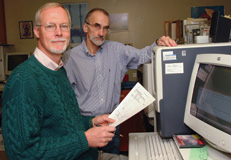 |
UF
Researchers Closer to Folate–Enriched Crops
downloadable
pdf
UF
Researchers Closer To Folate-Enriched Crops
Two University of Florida researchers and their collaborators
have found one of the genetic pathways to folate production
in plants — research that could lead to crops rich with
the birth defect-preventing nutrient to feed the developing
world.
“This may be the best way to combat folate deficiency
in some of the world’s most underdeveloped countries,
where the problem is most prevalent,” said Jess Gregory,
a professor at UF’s Institute of Food and Agricultural
Sciences.
 |
UF
nutrition Professor Jess Gregory, left, and Eminent Scholar
Andrew Hanson led a team of researchers in finding one
of the genetic pathways to the production of folate in
tomato plants and hope the finding brings scientists one
step closer to developing folate-enriched crops to feed
the developing world. |
Gregory
and UF eminent scholar Andrew Hanson, working on a $382,000
grant from the National Science Foundation, led a team of
researchers in finding a gene that is key to the production
of p-aminobenzoate, a substance plants use to make folate,
in tomatoes. Their team included researchers from the U.S.
Department of Agriculture; the University of Illinois in Chicago;
the Commissariat à l’Energie Atomique in Grenoble,
France; and the RIKEN Genomics Center in Yokohama, Japan.
Their research, which was published in the online edition
of Proceedings of the National Academy of Sciences, takes
them a step closer to breeding or genetically engineering
plants with higher levels of folate.
A form of vitamin B, folate is found in leafy green vegetables
such as turnip greens or spinach, as well as peas, beans and
fruit. Folate is particularly important during pregnancy and
fetal development, and a deficiency can lead to spina bifida
or other birth defects. Doctors have long advised women of
childbearing age — pregnant or not — to take vitamin
supplements containing folate. In 1998, concerns that Americans
weren’t getting enough of the nutrient led the U.S.
Food and Drug Administration to require that cereal, bread
and other grain products be fortified with folic acid, the
synthetic version of the vitamin.
The problem is much more serious in developing countries,
Gregory said. And in many of those countries, he said, it’s
difficult to make a vitamin-fortification program work.
“Typically in these countries, food processing and grain
milling are done by a large number of small, local processing
plants,” Gregory said. “With such a decentralized
food distribution system, it’s hard to put in place
a fortification program that can be monitored and controlled
effectively.”
In the past few decades, advances in genetic engineering have
allowed scientists to focus on a new way to get vitamins into
staple foods. Researchers can genetically alter certain crops
to produce larger amounts of certain vitamins, he said.
This approach, known as biofortification, has already produced
one well-known product. In the late 1990s, Swiss and German
researchers announced the creation of “golden rice,”
genetically altered to contain higher-than-normal levels of
beta-carotene, a nutrient that the human body can convert
to vitamin A. Advocates say the crop can help the millions
of people worldwide who suffer from vitamin A deficiency,
which can cause blindness and even death.
Hanson and Gregory hope to create a plant that will do for
folate what golden rice promises to do for vitamin A. But
getting there won’t be easy, the researchers say. That’s
because scientists have yet to identify all the genes responsible
for the complex set of processes plants undergo while making
the nutrient.
“Until you understand how this process works, you can’t
do engineering of the plants in a rational way,” Hanson
said.
The UF researchers chose to work with tomato plants because
the leaves of the plant contain lots of folate, while the
fruit — the part that makes its way to your salad bowl
— is relatively low in the nutrient.
“We know that as the fruit of the plant ripens, there
is a rapid drop in the expression of genes for folate synthesis,”
Hanson said. “Our goal is a fruit that continues to
make a lot of folate as it ripens.”
The UF researchers believe the tomato plant is a good choice
because it is a part of the diet in cultures around the world
— and because it is often consumed uncooked.
“Folate is very unstable, and a lot of it can be lost
when food is cooked,” said Hanson. “That’s
why we think it’s a good idea to start with fruits and
vegetables that aren’t always cooked before they’re
eaten.”
“Given the amount of interest in this in Europe, which
is traditionally fairly hostile to genetically modified foods,
I’d say there is definitely a market for folate-enriched
products,” Hanson said.
Andrew Hanson, adha@ifas.ufl.edu
Jess Gregory, jfgregory@ifas.ufl.edu
by Tim Lockette
|



